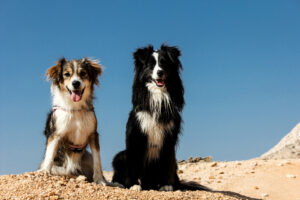Barks Blog
From 1 to 2…Smoothing the Transition

So you’ve decided after much decision and debate that another four-legged member will join your household. It’s definitely something that needs lots of careful consideration:
A quick checklist to think about:
- Should you choose a dog or a bitch? How does your existing dog get on with either and of course think about the obvious – is your current dog neutered? If you are going for a dog of the opposite sex and your current dog is entire, how are you going to work that out?
- Are you absolutely sure your dog will accept another canine and this is not just for your own benefit?
- What about your children or other family members, how do they feel?
- Have you got other pets (cats/small furries/others)? Think about their ages/personalities/temperaments/quirks etc., will they cope with another dog?
- What about holidays? Boarding or finding someone to look after two dogs may be harder than one
- Finances. Obviously now everything – vets fees, food, kenneling, equipment, training fees etc. is doubled!
- Household space and time – you need more of it!
Obviously the above is just a very short list and you will have thought about lots more scenarios, so what about when you know the big day is actually going to happen – what next? How to make the transition from one to two go really well.
Plan ahead. You will be going to view your new puppy several times, to choose him or her and then to watch the developmental progression. Take a new and clean cloth with you to wipe over the pup and transfer scent, or ask the breeder or rescue to do this. When you get home, place the scent cloth in your existing dog’s bed so that he/she can begin to acclimatize prior to the arrival.
Help your dog acclimate. Prior to your puppy’s arrival, start to set up the environment now with items you will have in place when she comes home – crate, bed, dishes etc. If you have these in place a few weeks prior to your puppy’s arrival, your existing dog can habituate to them and they won’t suddenly ‘appear’ and then ‘oh puppy comes too’. Make this transition smooth.
Think and discuss. Talk to everybody about your planned schedule when puppy comes home. How to you plan to schedule feeding, who is in charge primarily of toilet training, which room will puppy sleep in, how will you separate the dogs, where will the puppy go outside, what are your boundaries, what do you expect from puppy etc. All of you must agree and be consistent.
Buy the right things. There’s so much out there but you don’t need to go overboard! You’ll probably still have great items that your first dog loved, so re-use these. Buy items that are useful, age appropriate and remember that there may be some competition over resources, so ensure that your existing dog has his/her items as well as pup.
Provide safe space. Ensure your pup has a quiet corner and a den area in which to sleep, be free of people and your existing dog – puppies need sleep, peace and quiet.
First meetings. If possible, meet on neutral territory and through a barrier in a large open space. Bear in mind that your puppy will not be fully vaccinated so this must not be a public open space. This may not be possible for all, so if not, allow your puppy to meet your dog in somewhere open such as your garden or open yard rather than enclosed room/hallway of your house which may prove claustrophobic and threatening. It is very important that your existing dog does not become too boisterous and knock the puppy as they are very fragile and easily harmed.
Environment. Should be safe for a puppy. Think about the obvious in terms of electrical hazards, poisonous dangers in the garden/home but also slippery surfaces from tiled and laminate floors, steps etc.
Peace for your existing dog. Don’t neglect him! It’s very important that your puppy learns to respect your adult dog. Any persistent tail pulling, ear nipping or bullying should be gently discouraged.
Space and separate. Give each dog their own space. Own bowls, own beds, own toys and own space and don’t expect each dog to share.
Keep the routine. Keep your existing dog’s routine exactly the same as it always was. If you immediately change a routine just because pup has arrived, you will likely cause behavioral repercussions. Stick to the same walk times, feeding regime, keep with the games you play and all those funny little things you do together that your dog expects and loves.
Two dogs can be incredibly rewarding. The interaction between two dogs is something a dog-human partnership cannot quite recreate and is wonderful to watch. It can be a little daunting adding a new family member but if introduced carefully and with lots of thought, there should be little upheaval.
